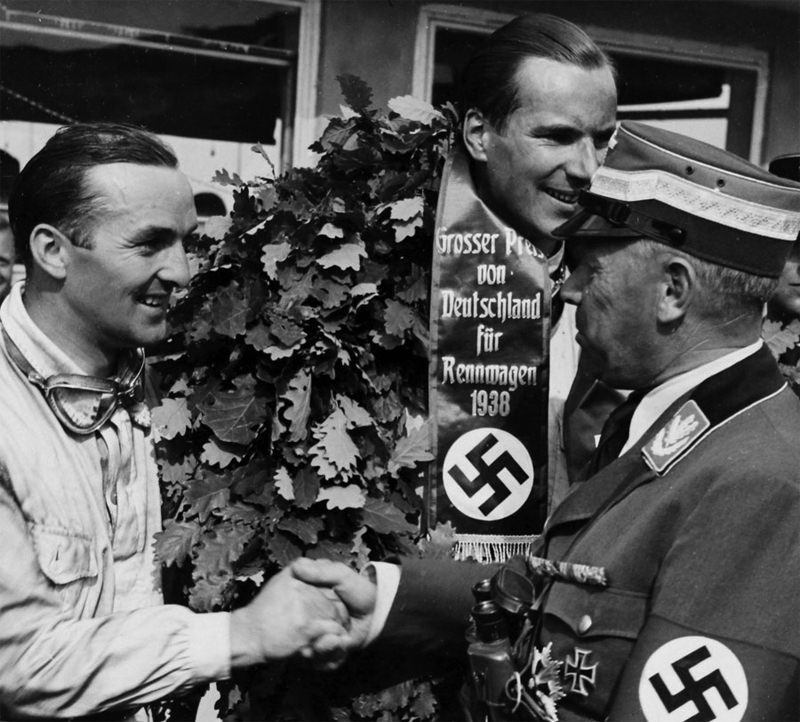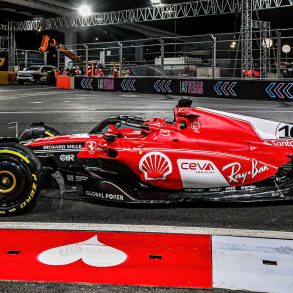1938 German Grand Prix – A Briton’s Finest Hour
By Cyril Posthumus
1939 Was the first year of the new 3-litre supercharged / 4½-litre unsupercharged GP Formula. Strictly this was a sliding scale Formula designed to place cars of all engine sizes from 666 c.c. to 4,500 c.c. on a level footing, but only Germany’s blown 3-litre twelve-cylinder Mercedes and Auto Unions had the performance to win, albeit at the cost of heavy fuel and tyre consumption. By the time the 11th German GP came round the situation had settled down with Mercedes the dominant marque. Auto Union, demoralized by the grievous loss of Bernd Rosemeyer in a record attempt, tagged along behind, Maserati were an erratic threat with a fast new eight-cylinder 3-litre, and France’s V-12 Delahayes had proved slow but reliable and easy on tyres and fuel.
But Auto Union prospects brightened at Nürburg with Nuvolari the Maestro joining the team to help combat the Mercedes might, while Varzi and Trossi were entered with two works Maseratis and Wimille with a blown single-seater Bugatti. Alas, these three all indexed, and the 20 remaining runners comprised four blown 3-litre V-12 Mercedes (Type 154), four Auto Unions (Type D with blown V- 12 units at the rear of a new frame with de Dion back end), two twelve-cylinder Type 312 Alfa Romeos, three eight-cylinder Type 308 Alfas, two 4.5 unblown Delahayes, Englishman A. B. Hyde’s old ex-Howe, ex-Cholmondeley-Tapper 3-litre Maserati, and four 1.5-litre Maseratis, all driven by independents.

Starting Grid
And this time the customary Nürburg efficiency was let down by the electric starting signal; the red and amber warning lights came on, but the green, due 20 seconds after, did not. Mercedes team manager Neubauer was, however, counting out the seconds for his drivers, ten fingers meaning ’10 seconds to go – engage first gear’. Counting down themselves from then, Lang tore away from Brauchitsch and Seaman while Nuvolari in his Auto Union shot past both into a brief second place.
Bursting out of the South Curve the order was Lang, Nuvolari, Seaman, Caracciola, Hasse, Brauchitsch, but before they vanished beyond the North Curve, Seaman was up into second place. At Brünnchen Mercedes became I-2-3, for Nuvolari, trying to steer and wipe a blob of oil from his screen at the same time, most uncharacteristically left the road backwards-Auto Unions were not Alfas! He got back into the race, but only to tour one more lap before retiring with damaged suspension. First A.U. out.

On lap 7 the mercurial Brauchitsch pulled in for new rear tyres, and Seaman and Caracciola passed – an Englishman leading the most important GP of the year! – and leading it in very smooth, competent style, too. Then he also stopped for a wheel-change, reverting to second position when Brauchitsch screamed through. After a pit stop for plugs a dejected Lang passed his sick car on to reserve driver Walter Baumer, but on lap 10 found himself back in a cockpit when Caracciola, suffering tummy troubles, handed his car over while holding third place.
Lap 11 (half distance) and it was No. 12 Brauchitsch, No. 16 Seaman (flustering the leader by the ease with which he matched his pace), and No. 10 Lang, then Hasse and Muller-until the latter stopped to change rear wheels and Nuvolari (enormously popular at the Ring) took over amid rousing cheers. Came the 16th lap, the second pit stop, and drama. All eyes were on the Mercedes pits when leader Brauchitsch swept in, gave a savage blip of throttle, cut out and stopped. White-clad mechanics rushed into action, while Seaman, to seconds back, pulled in behind. And, whereas Brauchitsch’s hard driving meant a tyre-change, Seaman’s smoother gait had conserved his.
The air was filled with the rush of feet, the clack of hammers and the excited buzz of the crowd, then Brauchitsch’s tank was overfilled, slopped over-and at that moment he switched on and a mechanic engaged the portable starter. The engine spat back and a collective gasp of horror arose from the packed stands as there came a vicious ‘whoof!’ and instantly the whole tail of the Mercedes became a mass of flames, rising swiftly above the two-tier pits. Brauchitsch, struggling to release his detachable steering wheel, was hauled bodily out of the cockpit by Neubauer and rolled on the ground to extinguish his burning sleeve, while the fire fighting squad went into action just as Seaman restarted, pulled out through the flames and smoke, and tore away into the lead.
The flames were quickly quelled; leaving three or four mechanics and the Mercedes well dowsed with thick white foam. Quickly it was wiped clean, when to a mighty roar of cheering Brauchitsch the pechvogel climbed back in, started up without mishap this time, and pluckily rejoined the race. But now Seaman was leading by over two minutes from Lang, Nuvolari and Stuck, Baumer in Lang’s cast-off had given up, the English amateur Hyde, utterly fatigued by fighting his difficult Maserati round, had overturned and hurt himself badly, and Hasse, too, had retired after a fine drive.
Then Brauchitsch was missing also. Shaken after the fire, bitter at the loss, once again, of the Grosser Preis when it seemed within his grasp, he misjudged the Schwedenkreuz corner and the Mercedes vanished down a deep ditch. Poor Brauchitsch climbed out unhurt and started to walk back, black in face and mood, carrying his detachable steering wheel, which, he declared, had detached itself as he took the corner. His mechanic Zimmer stoutly denies the possibility to this day.
So Richard Seaman in No. 16 Mercedes-Benz sped on to victory by 3 min 20 sec from Lang, Stuck and Nuvolari. For the first time since 1924 (when Seaman’s hero Segrave won at San Sebastian in a Sunbeam) a Bd won a major International Grand Prix; for the first time ever a Britishritish driver ha driver had won the German GP And in confirmation that Seaman was a worthy winner and not merely ‘rather lucky’ as he modestly declared in an interview, he changed tyres only once to Brauchitsch’s twice, yet comfortably held his pace, while his sixth lap in 10 min 09.1 sec (83.76 m.p.h.) proved the fastest of the day, unequalled by any of the Continental masters.
All Seaman said was ‘I only wish it had been a British car’
1938 German Grand Prix Results
| 1st | Dick Seaman | Mercedes-Benz | 3 hr. 51 min. 46.2 sec. | 80.71 mph |
| 2nd | Rudolf Caracciola, Hermann Lang | Mercedes-Benz | 3 hr. 55 min. 06.1 sec. | |
| 3rd | Hans Stuck | Auto Union | 4 hr. 00 min. 42.3 sec. |














